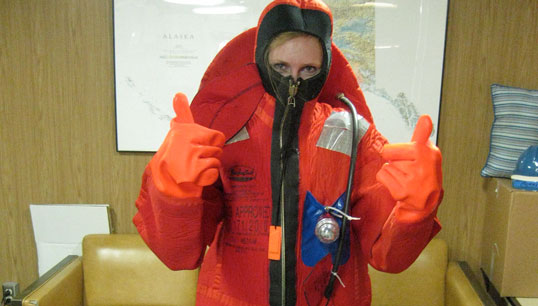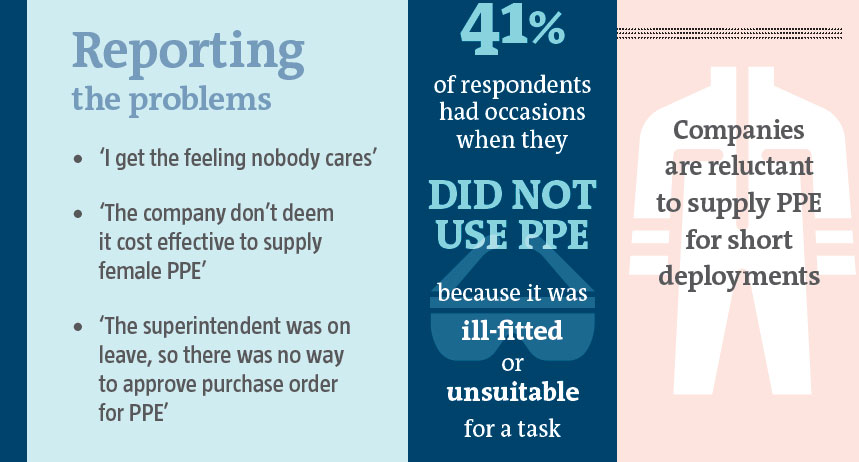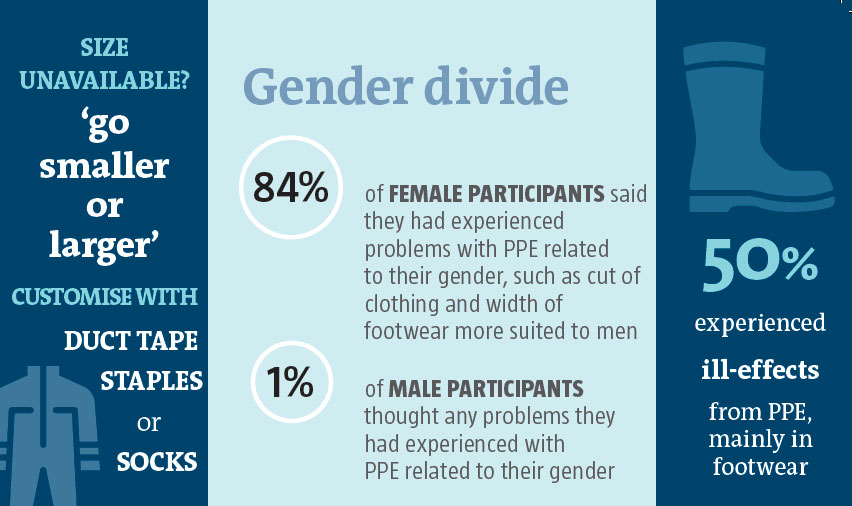- Topics
- Campaigning
- Careers
- Colleges
- Community
- Education and training
- Environment
- Equality
- Federation
- General secretary message
- Government
- Health and safety
- History
- Industrial
- International
- Law
- Members at work
- Nautilus news
- Nautilus partnerships
- Netherlands
- Open days
- Opinion
- Organising
- Switzerland
- Technology
- Ukraine
- United Kingdom
- Welfare
No size fits all when it comes to personal protective equipment for seafarers
18 August 2020

Following an appeal earlier in 2020 in the Telegraph and online, numerous seafarers took part in Solent University research to find out whether poorly-fitting personal protective equipment is creating hazards onboard ship. Now the results are in and the initial analysis is proving very interesting, as Dr Helen Devereux reports
In March 2020, researchers from Solent University working in partnership with the safety body CHIRP Maritime and Nautilus International, launched a questionnaire exploring seafarers' experiences of personal protective equipment (PPE).
The study was started after reading a report on the dangers of poorly-fitting PPE produced by the Confidential Human Factors Incident Reporting Programme (CHIRP).
Over one hundred seafarers completed the questionnaire and answered questions on issues such as how they felt various items of PPE fit them personally, whether they had experienced issues with PPE previously and how they had been able (or not) to resolve these issues.
In this article we look at the key findings from a preliminary analysis of the questionnaire data.
Who took part in the questionnaire?
Unsurprisingly, given the geographical locations of the three partner organisations, the vast majority of participants in the study were British (over 90%). The participants were predominantly male (83%), which is to be expected given the small number of females in the industry.
Those who completed the questionnaire ranged from seafarers with little experience (under one year) to one individual who stated they had worked in the industry for nearly five decades.
Respondents came from across the many different ship types and various sectors of the industry. They included seafarers employed onboard cruise vessels, ferries, tankers, container ships and offshore support vessels, amongst others. Participants were also from across the onboard departments (59% deck, 38% engineering) and were predominantly employed in officer roles (82% officer, 8% rating, 10% other).
Again, given the higher prevalence of officers in comparison to ratings among British seafarers generally, these findings are to be expected.
Sourcing PPE
Seafarers who participated in the study were asked where they obtained their PPE. Some 65% stated they obtained it from stores onboard the vessel at the start of each trip. Another 10% said they purchased their own to take to the ship, whilst 9% said the shipping company purchased it and sent it to their home address for them to take onboard.
Of those who stated they obtained their PPE from the stores onboard, many stated that they had experienced occasions when the size they required had not been available. One stated: 'This happens all the time. You just have to get a smaller or bigger size.'
Worryingly, another said: 'I've never had a full set of issue gear that fits. After spending my first trip with duct tape and staples adjusting my overalls and extra socks to fill boots, I just started taking it with me.'
It was particularly concerning to read one cadet describe his experience as follows: 'Due to deployments being short, companies are reluctant to give out PPE – for the first week of an Icelandic cruise I had no coat or jumper so had to do mooring in my shirt sleeves in freezing temperatures.'
The comment made by the cadet indicates that such PPE was available but the cadet was not provided with it immediately, instead having little option but to risk his own health and safety.
In addition to asking how the seafarers who took part in the study obtained PPE at the beginning of a tour, the questionnaire also asked what happened if they needed new PPE during a tour. The vast majority (93%) of those who completed the question stated that the company would provide them with it free of charge if needed during a tour.
Problems with PPE
Seafarers were asked whether or not they had experienced any problems with their PPE. Over one third (35%) reported that they had experienced problems with PPE during their most recent tour. This number rose substantially to 73% of seafarers when asked if they had experience problems with their PPE during their entire employment at sea.

Given findings from other industries, such as the UK healthcare sector, it was not surprising to see that when female seafarers' responses were considered separately to males, 94% of females stated that they had experienced problems with PPE during their employment at sea.
The Code of Safe Working Practices dedicates a whole chapter to PPE, and states that suitable equipment should both fit the seafarer correctly after any necessary adjustment and take account of ergonomic requirements.
However, when asking participants how individual items of PPE fitted them during their most recent tour of duty, the findings were stark. Some 19% of respondents stated that their boiler suit fitted them either poorly or not at all. Over a quarter (26%) of respondents said that their gloves had fitted them either poorly or not at all.
One participant stated that 'Gloves are too big to work with' whilst another said 'The gloves I was wearing were large. I had a better grip without them.' Similar numbers of respondents (12%, 13% and 11% respectively) reported safety footwear/boots, protective eyewear and safety harnesses to either fit poorly or not at all.
Given the responses regarding poorly fitting PPE, it was not surprising that half of all participants reported that they had experienced ill-effects from PPE. Many of these ill-effects were related to safety footwear, with participants reporting issues such as: 'Inadequately fitting boots, blisters on toes from constant rubbing.' Some of the ill-effects were reported as being the result of using poor quality items. One respondent stated: 'Boots, cheap made ones not flexible enough, causing blisters.'
Others however, were clear that the ill-effects were the result of utilising equipment that did not fit them sufficiently. For example, one respondent said they experienced 'bruised knees as knee pad areas on boiler suits are near my ankles due to leg lengths.' Similarly, another stated the ill-effects were a consequence of: 'wearing boots that were too small as nothing else available.'
One question in the survey asked seafarers if the shipping company they work for has a specific procedure for reporting problems with PPE. The responses to this question varied substantially, with some stating their employer to have no procedure whatsoever and others saying they had a formal procedure including investigations carried out by the shipping company when any problems with PPE were reported.
PPE plays a very important part in controlling the risks faced by seafarers, yet 10% of respondents felt the need to buy their own PPE before joining a ship
Gender
This questionnaire did not specifically set out to focus on PPE and gender, as we already know from previous research that PPE is designed and manufactured based on the sizes and characteristics of male populations from certain regions and thus it was likely that some males, such as those who were particularly tall or short might also experience problems with PPE.
Nevertheless, since the design of PPE is known to be focused on males, the questionnaire asked: Do you think there are any problems with PPE which are related to your gender?
Some 82% of females stated yes, whilst only 1% of males did. In answering what she thought the problems were, one female stated: 'Boiler suits are issued in large sizes, safety shoes are often very wide as they are men's, gloves are usually too big. Uniform is often issued to women in men's sizes. I have often found that smaller sizes are not kept onboard.'

Similarly, another stated: 'Not small enough shoe sizes, clothing doesn't fit around hips well and can bunch up or can't get the clothing past your hips. Struggling to fasten clothing across chest so either leave open or it gapes open so have to wear T-shirt or something similar underneath.'
Research from other industries indicates that PPE can be a particular issue to women. In 2016 the Trades Union Congress conducted a survey of women workers in various shore-based industries including the Police and Coastguard. Some 57% of women who participated in that survey reported that their PPE sometimes or significantly hampered their work.
Use of PPE
The participants were asked about their use of PPE, and 41% of respondents stated that there were occasions when they had not used it. Many of the respondents' reasons for not using PPE relate to certain items being ill-fitting or unsuitable for a particular task. For example, one stated: '[I have] occasionally not donned boiler suit as it is poorly fitting for very quick tasks.' Another stated: 'Due to issues the white safety shoes have caused to my feet I have found myself on mooring stations with white trainers.'
Seafarers not using PPE is concerning. In a safety critical industry in which it is not possible to remove all risks, PPE plays a very important part in controlling the risk faced by seafarers. PPE, when used correctly, reduces the likelihood of seafarers experiencing harm. COSWP states that the use of PPE can help to reduce certain injuries, such as the use of gloves to reduce hand injuries when handling sharp or hot items.
Company support
Whilst the questionnaire did not specifically ask about the support provided by shipping companies in ensuring crews had access to PPE which was fit for purpose, several of the respondents commented on a lack of support from their employers.
Specifically, one individual stated that they had 'brought up the lack of glove sizing variety with superintendent; he said noted'. The seafarer went on to conclude: 'I get the feeling nobody really cares.'
A female seafarer suggested that 'being one of a handful of females in the fleet, [the] company don't deem it cost effective to supply limited female PPE.'
Some seafarers also shared their experiences of dealing with shore side when trying to procure PPE for use onboard. One senior officer explained his experience of purchasing PPE: '[The] Superintendent [was] on leave, so [there was] no way to approve purchase order for PPE. [I] ordered online using my company credit card [and] got a snotty email from finance department about using company credit card despite the fact we have an account with the supplier.'
Conclusions
We know that PPE must fit properly for it to be fully protective and it needs to fit to be usable and therefore actually worn. Without properly fitting PPE that seafarers can use in the conditions they are working in, some seafarers may be harmed. Therefore the findings from this questionnaire raise several important points which ought to be further explored. It is clear from the findings that a substantial number of both male and female seafarers have experienced issues with PPE. The issues relate both to PPE being ill-fitting and the PPE they use being of poor quality. With regards to poor fitting PPE, the findings indicate that women seafarers are significantly more likely to experience issues than their male counterparts.
Survey backer CHIRP Maritime commented: 'The findings of this study validate the concerns of the many reports that CHIRP Maritime has received on this matter. It also asks questions of some employers as to their understanding of the risks associated with PPE and their duty of care over their employees. To be clear: Safety is not negotiable.'
What next?
Researchers at Solent University will be conducting more in-depth analyses to explore the findings in more detail and consider, for example, any variation in the findings in relation to various factors such as physical characteristics and working arrangements.
Nautilus also intends to work with shipping companies both in order to draw their attention to the findings from this study (and others) and to gain a greater understanding of the procedures relating to the procurement of PPE.
Tags
More articles
Have your say: is wrong-size personal protective equipment putting seafarers at risk?
Navigating the crew change crisis – how uncertainty at work can be a threat to seafarer wellbeing
£1.5m boost for maritime technology innovation
Eleven maritime technology projects have been awarded grants totalling £1.5m to help promote innovation in the sector.
